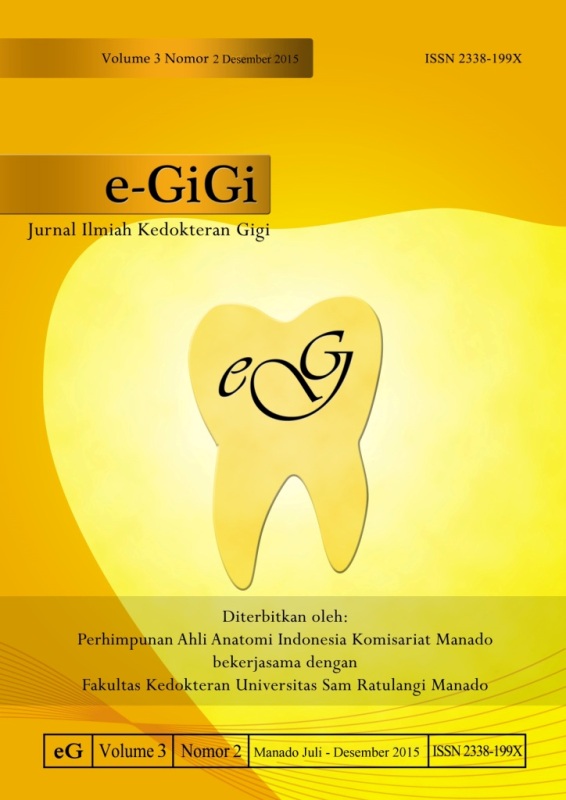GAMBARAN PERAWATAN GIGI DAN MULUT PADA BULAN KESEHATAN GIGI NASIONAL PERIODE TAHUN 2011 DAN 2014 DI RSGMP UNSRAT
DOI:
https://doi.org/10.35790/eg.3.2.2015.8766Abstract
Abstract: Dentists in Indonesia in order to improve the health of society, shall act as a motivator, educator, and providers of health services (preventive, promotive, curative, and rehabilitative). Dentists have to serves in an efficient, effective, and qualified in accordance with the needs and demands of patients when providing health service. This study was conducted to describe the oral cares in the Bulan Kesehatan Gigi Nasional periods of 2011 and 2014 in RSGMP Unsrat. The research design used was descriptive with retrospective approach. The population is the entire patient record in BKGN periods in 2011 and 2014 in RSGMP Unsrat each numbered 1372 and 1327 records. Sampling was done by using total sampling technique. The sample size in this study after seeing the inclusion and exclusion criteria was 1237 in the period of 2011 and 1079 in the period of 2014. The results showed that the percentage of oral cares according to sex in BKGN periods in 2011 and 2014 showed that female gender is higher than men. The percentage of oral cares by age group in BKGN period in 2011 shows that the age group 0-11 years is higher than other age groups. The percentage of oral cares highest in the age group 12-25 years was only found in the permanent tooth extractions and scaling. The percentage of oral cares by age group in BKGN period in 2014 showed that the oral cares in the age group 0-11 years are fissure sealants and topical application fluoride. Oral cares highest in the age group 12-25 years is scaling. The highest oral cares at BKGN in the periods of 2011 and 2014 is scaling.
Keywords: oral cares, scaling, permanent tooth extraction, fissure sealant, topical application fluoride
Abstrak: Doker gigi di Indonesia dalam rangka meningkatan derajat kesehatan masyarakat, wajib bertindak sebagai motivator, penididik, dan pemberi pelayanan kesehatan (preventif, promotif, kuratif, dan rehabilitatif). Dokter gigi wajib bertindak efisien, efektif, dan berkualitas sesuai dengan kebutuhan dan permintaan pasien saat melakukan pelayanan kesehatan. Penelitian ini dilakukan untuk mengetahui gambaran perawatan gigi dan mulut pada Bulan Kesehatan Gigi Nasional periode tahun 2011 dan 2014 di RSGMP Unsrat. Jenis penelitian yang digunakan yaitu deskriptif dengan pendekatan retrospektif. Populasi yang digunakan yaitu seluruh rekam medik pasien pada BKGN periode tahun 2011 dan 2014 di RSGMP Unsrat yang masing-masing berjumlah 1372 dan 1327 rekam medik. Pengambilan sampel dilakukan dengan teknik total sampling. Besar sampel pada penelitian ini setelah melihat kriteria inklusi dan ekslusi menjadi 1237 pada periode tahun 2011 dan 1079 pada periode tahun 2014. Hasil penelitian menunjukkan bahwa persentase perawatan gigi dan mulut menurut jenis kelamin pada BKGN periode tahun 2011 dan 2014 menunjukkan bahwa jenis kelamin perempuan lebih tinggi daripada laki-laki. Persentase perawatan gigi dan mulut menurut kelompok umur pada BKGN periode tahun 2011 menunjukkan bahwa kelompok umur 0-11 tahun lebih tinggi daripada kelompok umur lainnya. Persentase perawatan gigi dan mulut tertinggi pada kelompok umur 12-25 tahun hanya ditemukan pada pencabutan gigi permanen dan scaling. Persentase perawatan gigi dan mulut menurut kelompok umur pada BKGN periode tahun 2014 menunjukkan bahwa perawatan gigi dan mulut tertinggi pada kelompok umur 0-11 tahun yaitu fissure sealant dan aplikasi fluor topikal. Perawatan gigi dan mulut tertinggi pada kelompok umur 12-25 tahun yaitu scaling. Perawatan gigi dan mulut terbanyak pada BKGN periode tahun 2011 dan 2014 yaitu scaling.
Kata kunci: perawatan gigi dan mulut, scaling, pencabutan gigi permanen, fissure sealant, aplikasi fluor topical
Downloads
How to Cite
Issue
Section
License
COPYRIGHT
Authors who publish with this journal agree to the following terms:
Authors hold their copyright and grant this journal the privilege of first publication, with the work simultaneously licensed under a Creative Commons Attribution License that permits others to impart the work with an acknowledgment of the work's origin and initial publication by this journal.
Authors can enter into separate or additional contractual arrangements for the non-exclusive distribution of the journal's published version of the work (for example, post it to an institutional repository or publish it in a book), with an acknowledgment of its underlying publication in this journal.
Authors are permitted and encouraged to post their work online (for example, in institutional repositories or on their website) as it can lead to productive exchanges, as well as earlier and greater citation of the published work (See The Effect of Open Access).






